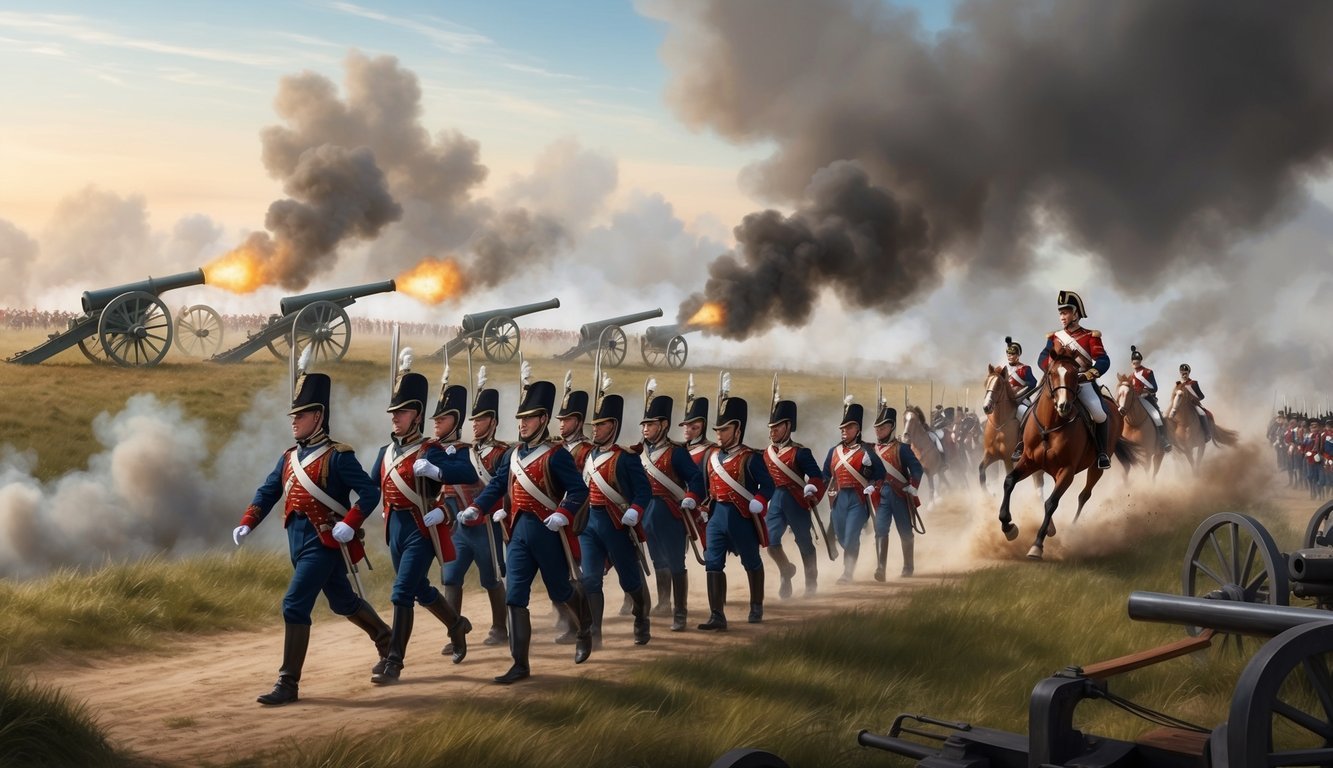Historical war games transport you straight into the heart of epic conflicts from ages past.
Whether you’re a history buff or just enjoy strategic gameplay, these immersive experiences let you rewrite the course of famous battles and shape entire civilizations.
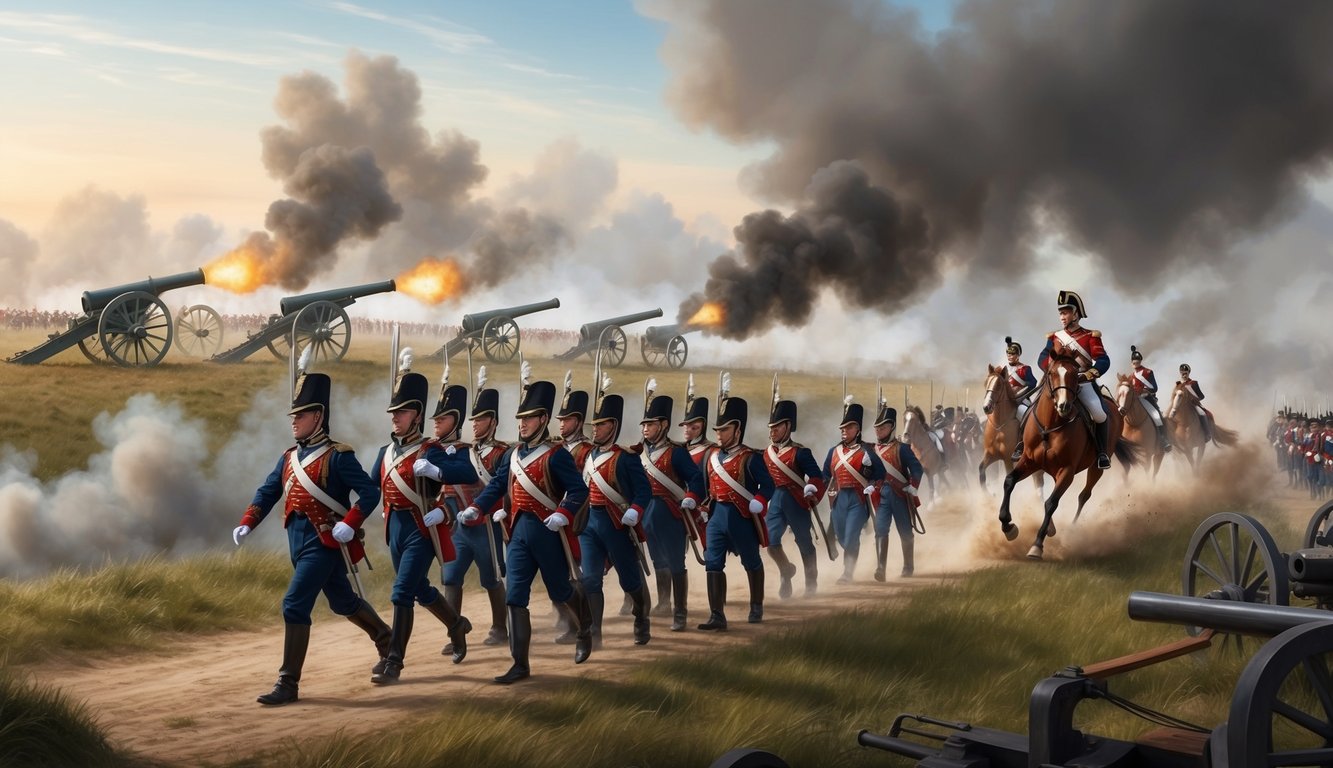
The best historical war games combine rich period detail with engaging mechanics that capture the essence of warfare in different eras. You might find yourself commanding Roman legions, leading samurai armies in feudal Japan, or orchestrating massive tank battles in World War II.
Many of these games impress with their attention to historical accuracy, featuring authentic unit types, weapons, and realistic maps of ancient empires.
Beyond just military strategy, many historical war games also let you manage the economic and political aspects of your faction.
You’ll need to balance resources, forge alliances, and make tough decisions that can alter the fate of nations.
It’s a thrilling way to experience history hands-on and gain a deeper appreciation for the complexities of warfare throughout the ages.
Evolution of Historical War Games
Historical war games have come a long way, transforming from simple board games to complex digital simulations.
Technological advancements have revolutionized how these games are developed and played.
From Board Games to Digital
Early war games started as physical board games, using pieces to represent military units.
You might remember classics like Risk or Stratego.
These games laid the foundation for strategic thinking and historical reenactment.
As computers emerged, digital war games began to take shape.
Games like Panzer General introduced you to more detailed historical scenarios.
The shift to digital allowed for more complex rule systems and realistic simulations.
Strategy games like Civilization brought a new dimension to historical gaming.
You could now guide entire civilizations through millennia, making decisions that shaped history.
Impact of Technology on Game Development
Technology has dramatically changed how war games are created and experienced. 3D graphics and powerful processors allow for stunning visual representations of historical battles.
You can now engage in multiplayer battles online, facing off against opponents worldwide.
This connectivity has created thriving communities of history enthusiasts and strategy gamers.
Games like Sid Meier’s Civilization V showcase the potential of modern historical games.
You’re presented with intricate systems modeling economics, diplomacy, and warfare across different eras.
AI advancements have improved opponent behavior, making computer-controlled enemies more challenging and realistic.
You’ll find yourself up against smarter, more adaptable foes.
Key Franchises and Titles
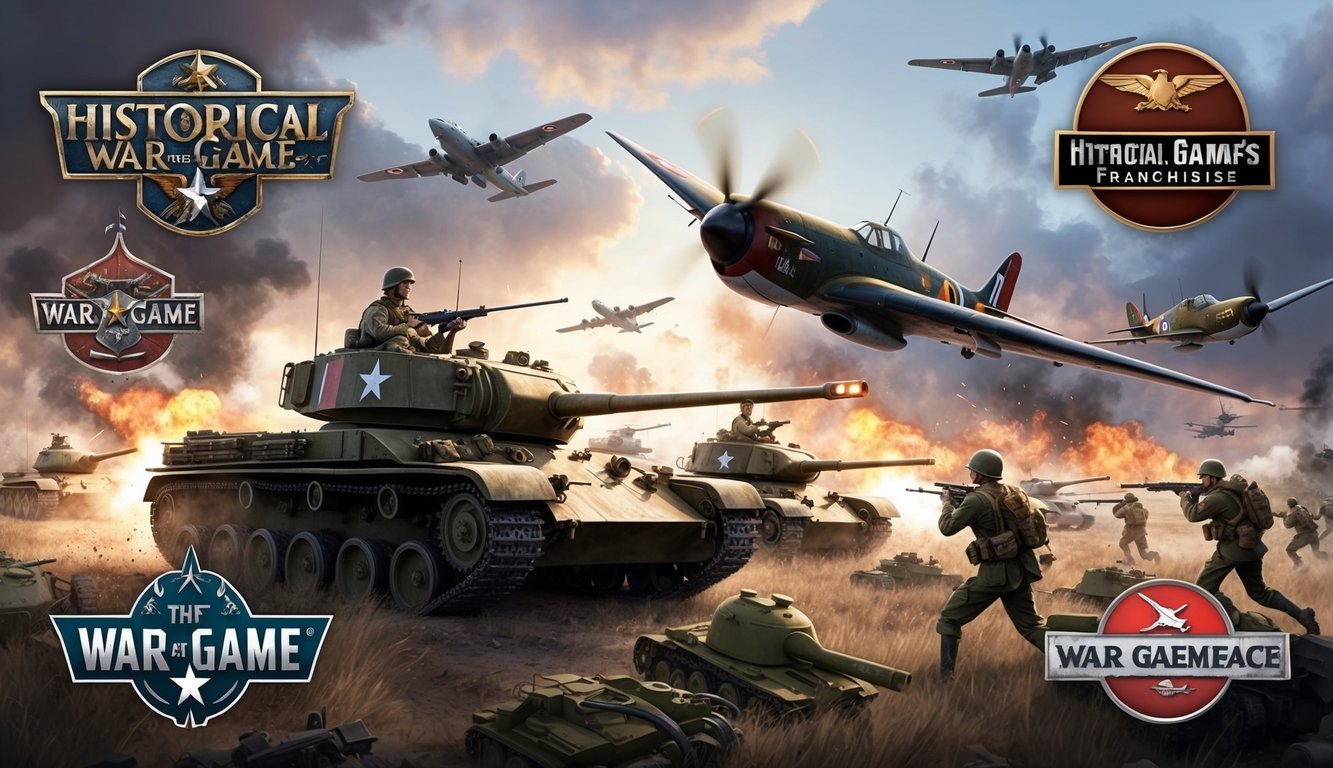
Historical war games have been dominated by a few standout franchises that offer immersive experiences across different eras.
These series have shaped the genre through innovative gameplay mechanics and rich historical detail.
Civilization Series Impact
You’ve probably heard of Sid Meier’s Civilization.
It’s a titan in the 4X strategy world.
Civilization V and VI let you guide a civilization from ancient times to the space age.
You’ll make crucial decisions about expansion, technology, and diplomacy.
In Civilization VI, you’ll manage cities, conduct research, and engage in warfare across beautifully detailed maps.
The game’s unique district system adds depth to city planning.
You’ll need to balance resource management with military strategy to outmaneuver rival civilizations.
The series’ addictive “one more turn” gameplay keeps you coming back for more.
With each new installment, Civilization refines its formula while staying true to its historical roots.
Total War’s Epic Scale
Total War games drop you into massive historical conflicts.
Total War: Three Kingdoms stands out with its blend of historical accuracy and character-driven narratives.
You’ll command vast armies in real-time battles while managing your empire on a turn-based campaign map.
The series is known for its attention to detail in unit types and battlefield tactics.
You’ll need to consider terrain, troop positioning, and morale as you fight across ancient China.
Three Kingdoms introduces a unique character system.
Your generals have distinct personalities and relationships that affect gameplay.
This adds a personal touch to the grand strategy experience.
Company of Heroes’ Tactical Brilliance
Company of Heroes 2 puts you in command of World War II squads.
You’ll lead troops through intense, tactical battles on the Eastern Front.
The game’s cover system and destructible environments create dynamic battlefields.
Resource management is key.
You’ll capture points to gain fuel and manpower for reinforcements.
Weather plays a crucial role too.
Your soldiers can freeze in harsh winter conditions if you’re not careful.
The Definitive Edition adds new content and improves graphics.
You’ll enjoy remastered campaigns and additional factions.
The game’s multiplayer scene remains active, offering endless strategic challenges against other players.
Gameplay Mechanics and Design
Historical war games offer unique gameplay experiences through carefully crafted mechanics and designs.
These elements work together to create engaging simulations that transport you back in time.
Building a Civilization from Scratch
In many historical war games, you start with a fledgling civilization or empire.
You’ll need to manage resources, develop technologies, and expand your territory.
As you progress, you’ll construct buildings, train units, and research advancements.
Some games let you choose from various historical civilizations, each with unique bonuses and abilities.
This adds replay value and encourages you to try different strategies.
Resource management is often a key component.
You’ll need to balance food production, military spending, and technological development.
Making smart choices early on can set you up for success later in the game.
Conquest and Strategy
Conquering new territories is a central aspect of many historical war games.
You’ll need to plan your military campaigns carefully, considering factors like terrain, unit types, and supply lines.
Combat mechanics vary between games.
Some use turn-based systems, while others feature real-time battles.
You might control individual units or entire armies, depending on the game’s scale.
Diplomacy often plays a crucial role.
You can form alliances, negotiate trade deals, or intimidate rivals.
These interactions add depth to the gameplay and reflect the complexities of historical politics.
Many games include random events or historical scenarios that challenge your adaptability.
You might face natural disasters, rebellions, or invasions from unexpected directions.
Role of User Interface
A well-designed user interface (UI) is crucial for historical war games.
It helps you manage complex systems without feeling overwhelmed.
Most games feature a main map view where you can see your empire and surrounding territories.
Overlays and filters let you view different types of information, like resource distribution or military strength.
Menus and panels provide access to detailed information about your civilization’s status.
You’ll find economic reports, military rosters, and diplomatic relations here.
Tooltips and help screens are common features that explain game mechanics and historical context.
These can be especially helpful for newcomers to the genre.
Some games incorporate historical artwork or period-appropriate design elements into their UI.
This enhances the immersive experience and adds to the game’s atmosphere.
Noteworthy Eras and Settings

Historical war games transport you to iconic periods of conflict.
These settings offer unique challenges and strategic opportunities based on the warfare and technology of each era.
The Attraction of World Wars
World War I and World War II dominate many historical war games.
In WWI titles like “The Great War: Western Front,” you’ll face the grim realities of trench warfare.
Expect slow advances and high casualties as you coordinate artillery and infantry attacks.
WWII games like “Call of Duty: WWII” put you in the thick of famous battles.
You’ll storm the beaches of Normandy, fight through bombed-out cities, and command diverse units.
These games often highlight technological advancements like tanks, aircraft, and new weapons that changed warfare forever.
Some WWII games focus on specific theaters. “Company of Heroes” lets you lead Allied forces through the Mediterranean and Western Europe.
You’ll manage resources, build bases, and coordinate combined arms tactics.
The Roman Empire’s Eternal Appeal
Roman-era games let you build and defend one of history’s greatest empires.
You’ll lead legions, manage provinces, and deal with both external threats and internal politics.
Many games in this setting, like some “Total War” titles, span centuries.
You might start with a small city-state and gradually conquer the known world.
You’ll face barbarian invasions, rival empires, and civil wars.
These games often include intricate political systems.
You’ll navigate the Roman Senate, manage governors, and deal with rebellious generals.
The fall of the Western Roman Empire is a popular focus, letting you try to change history.
Feudalism and the Middle Ages
Medieval war games plunge you into a world of knights, castles, and feudal politics.
You’ll often start as a minor noble, working to expand your influence and territory.
Many games in this era, like some entries in the “Total War” series, feature a mix of grand strategy and tactical battles.
You’ll manage your dynasty, forge alliances, and lead armies into combat.
Siege warfare is often a key element.
You’ll build and defend castles, use trebuchets and battering rams, and command units of archers and cavalry.
Some games also include elements of crusades or struggles against invaders like the Huns.
Accuracy and Representation
Historical war games strive to balance realism with entertainment.
They aim to recreate past conflicts while providing engaging gameplay experiences.
This delicate balance sparks ongoing debates about historical authenticity in gaming.
Balancing Fact and Fun
You’ll find that games like Total War: Attila try to blend historical accuracy with enjoyable gameplay.
The developers research extensively to recreate the look and feel of ancient warfare.
They include authentic units, tactics, and political systems.
But they also take some liberties to make the game more fun.
For example, battles might be sped up or simplified.
This keeps you engaged without getting bogged down in every historical detail.
The key is finding a sweet spot between realism and playability.
The Debate Over Historical Accuracy
Gamers and historians often argue about how accurate war games should be.
Some players want perfect historical recreations, while others prefer a more cinematic experience.
Battlefield 1 sparked heated discussions when it was released.
The game portrayed World War I with some creative liberties.
You could use weapons that were rare in real life, and the pace of combat was faster than actual trench warfare.
Critics argued these choices misrepresented history, while defenders said it made for a better game.
This ongoing debate shows how passionate players are about authenticity in historical settings.
The Single-Player Experience
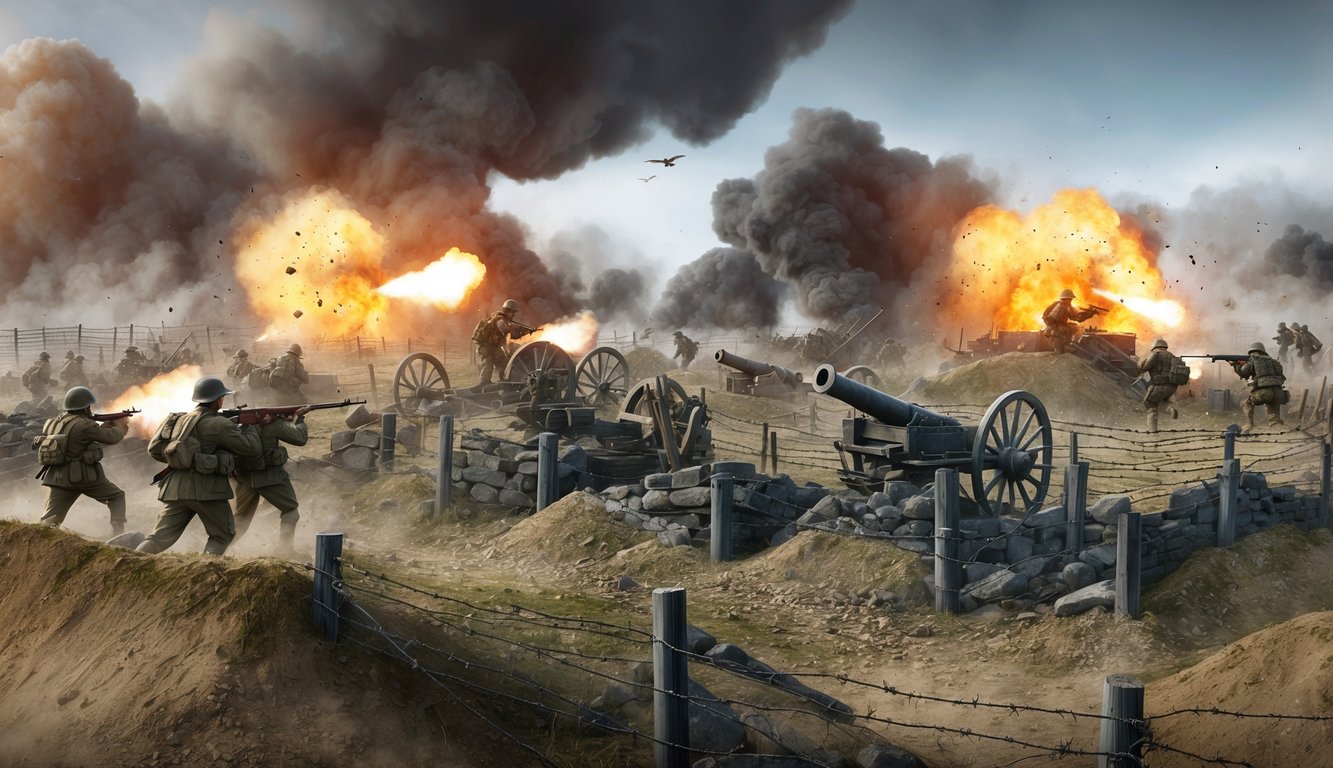
Historical war games offer captivating solo adventures that transport you to pivotal moments in military history.
You’ll find yourself immersed in richly detailed campaigns and narratives that bring past conflicts to life.
Campaigns That Tell a Story
Single-player campaigns in historical war games let you relive famous battles and operations.
You might lead Allied forces in World War II’s D-Day invasion or command Roman legions in ancient Gaul.
These campaigns often follow a chronological progression, allowing you to shape the course of history.
Games like “Old World” blend grand strategy with personal narratives.
They let you guide a civilization while managing family dynamics and political intrigue.
You’ll make decisions that impact not just military outcomes, but the cultural and economic development of your nation.
Some titles offer branching storylines where your choices alter historical events.
This adds replay value and lets you explore “what if” scenarios.
Immersion Through Narrative
Historical war games use various techniques to pull you into their worlds.
Detailed character backstories and in-game journals help you connect with your troops and commanders.
You’ll often encounter historical figures, adding authenticity to your experience.
Cutscenes and voiceovers bring key moments to life, from rousing pre-battle speeches to tense war room debates.
Many games incorporate period-accurate music, sound effects, and visuals to create a convincing atmosphere.
Some titles use a mix of fictional characters and real events to craft compelling personal stories within larger conflicts.
This approach helps you relate to the human side of warfare while learning about historical contexts.
Multiplayer Dynamics
Historical war games shine brightest when you pit your strategic skills against other players.
The multiplayer experience adds depth and unpredictability, turning each match into a unique historical saga.
Competing Against History Buffs
You’ll find a mix of casual players and hardcore history enthusiasts in multiplayer matches.
In games like Crusader Kings 3, you might face opponents who know every detail of medieval European politics.
This can be intimidating but also educational.
These history buffs often use authentic strategies from the era.
You’ll learn new tactics as you play against them.
Don’t be surprised if someone recreates a famous battle or alliance from history.
Some players even roleplay as historical figures.
You might encounter a “Henry VIII” determined to break from the Catholic Church or a “Charlemagne” bent on uniting Europe.
Online Alliances and Rivalries
In multiplayer games like Europa Universalis IV, you’ll form complex relationships with other players.
Alliances can shift rapidly as you all try to outmaneuver each other.
You might team up with France to take on the Holy Roman Empire, only to be betrayed later.
These evolving dynamics make each game session unique and exciting.
Some players form long-term rivalries that span multiple matches.
You might find yourself repeatedly clashing with the same opponent over control of the Mediterranean or the New World.
Online communities often organize massive multiplayer campaigns.
You could join a game with dozens of players, each controlling a different nation.
These epic struggles can last for weeks or even months.
Game Mods and Community
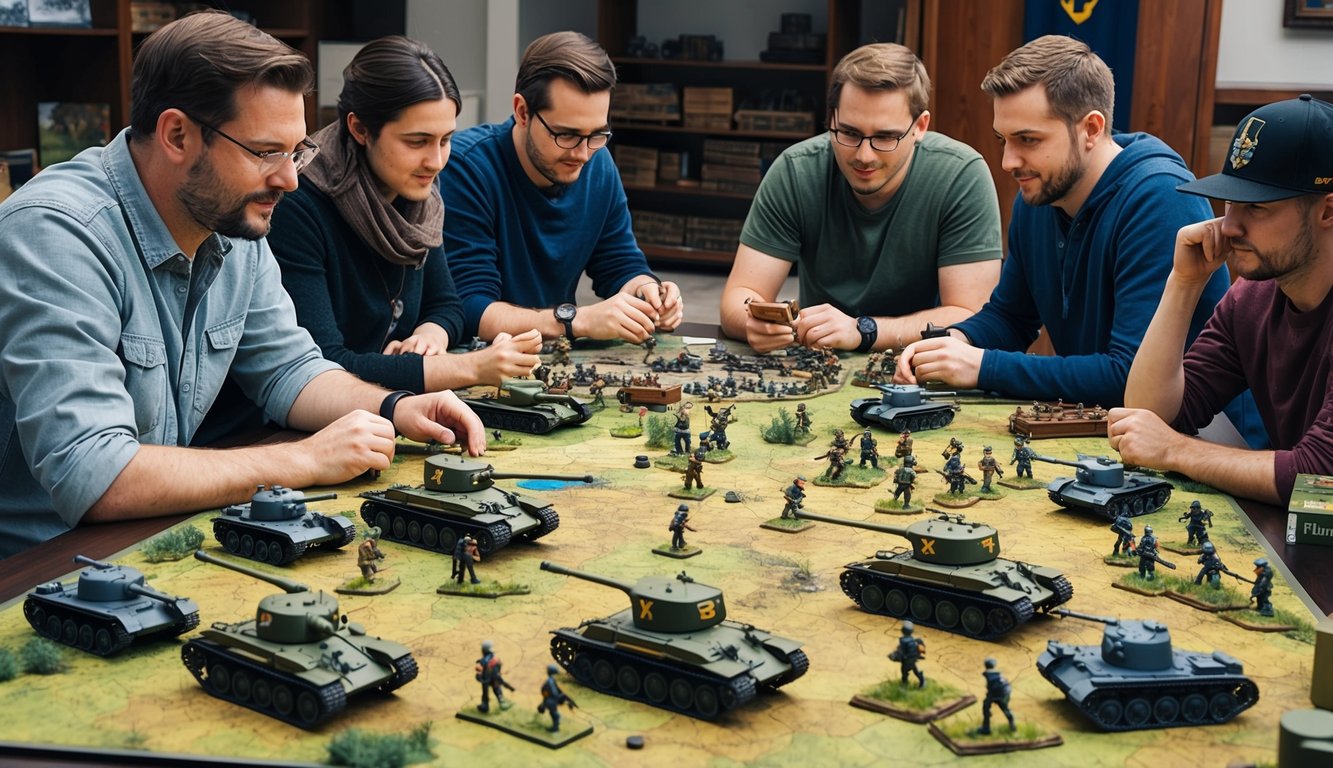
Game mods and community contributions breathe new life into historical war games.
They expand gameplay options and allow you to experience conflicts from different perspectives.
Extending the Life of Games
Mods can dramatically extend how long you’ll enjoy playing historical strategy games.
For Sid Meier’s Civilization VI, you’ll find mods that add new civilizations, leaders, and scenarios based on real historical events.
Some overhaul the entire game, letting you play through specific time periods like ancient Rome or World War II in greater detail.
Community-made maps recreate famous battlefields or entire historical eras.
You can download mods that improve graphics, add new units, or tweak gameplay mechanics.
This constant flow of fresh content keeps games engaging long after release.
Player Contributions
The modding community brings incredible creativity to historical war games.
You’ll see passionate players with deep historical knowledge creating intricate scenarios.
For games like Mount & Blade II: Bannerlord, mods add historically-inspired factions and conflicts.
Players share custom missions, campaigns, and even total conversions that transform games into new experiences.
You can find mods that increase realism, add fantasy elements, or recreate specific battles in meticulous detail.
Community forums buzz with strategy discussions, mod recommendations, and player-run multiplayer events that bring history to life.
Challenges and Controversy
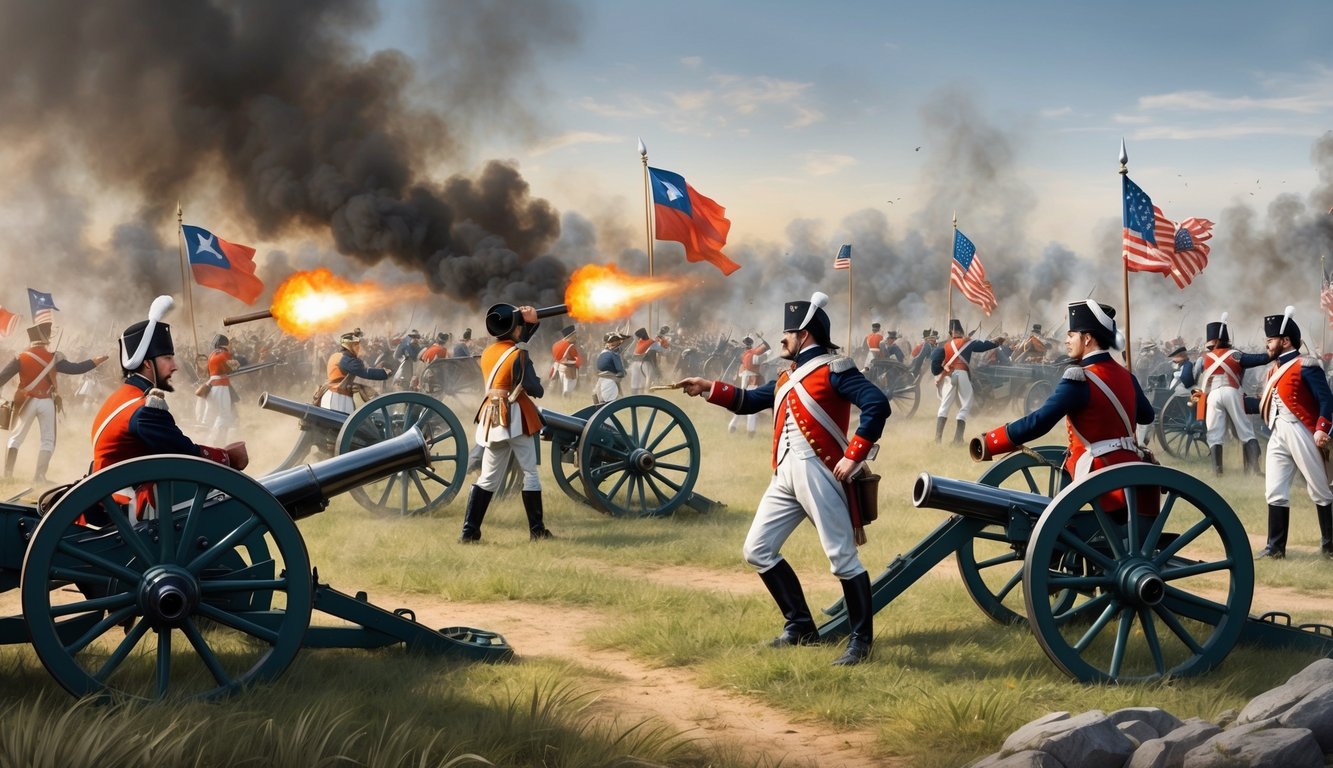
Historical war games face complex issues around accuracy and sensitivity.
You’ll find heated debates about how these games portray past conflicts and their impact on players’ understanding of history.
Dealing With Sensitive Topics
War games often tackle difficult subjects like genocide, civilian casualties, and war crimes.
You might wonder how developers approach these heavy topics.
Some games avoid graphic depictions, using symbols or off-screen events instead.
Others confront brutality head-on, sparking discussions about ethics in gaming.
Developers wrestle with balancing historical accuracy and player agency.
Should you be able to change major outcomes? Games like “Czechoslovakia 38-89: Assassination” use real testimonies to ground fictional scenarios in truth.
Reception and Criticism
Players and critics scrutinize war games for their portrayal of history.
You’ll find praise for titles that educate alongside entertainment.
But some games face backlash for glorifying violence or oversimplifying complex conflicts.
Historians debate the role of games in shaping public understanding.
Can you trust games as historical sources? Research shows players often rank games lower than books or documentaries for accuracy.
Yet, games can spark interest in history and encourage further learning.
Cultural sensitivities also come into play.
A game’s perspective on past conflicts might be seen as biased or offensive in certain regions, leading to bans or modifications.
The Future of Historical War Games
Historical war games are evolving rapidly with new technologies and player expectations.
Exciting developments are on the horizon for strategy game enthusiasts.
Trends and Predictions
You’ll see more immersive experiences in upcoming historical war games.
Developers are focusing on hyper-realistic graphics and AI-driven enemy behaviors.
Expect games that blend real-time and turn-based elements for deeper strategic gameplay.
Multiplayer modes will likely expand, allowing you to command massive armies alongside friends.
Mobile versions of popular PC titles are also in the works, so you can wage war on the go.
Historical accuracy will remain crucial, but with more player agency to explore “what-if” scenarios.
You might rewrite history in games that offer branching storylines based on your decisions.
The Role of Virtual Reality
VR is set to revolutionize how you experience historical war games.
You’ll soon be able to step into the shoes of famous commanders, surveying battlefields from a first-person perspective.
Imagine planning your strategy while walking through a virtual war room.
In this room, you can move unit markers on a 3D map.
VR will bring tactile elements to strategy games, letting you physically interact with your army and terrain.
These immersive experiences will also serve educational purposes.
You’ll learn about historical conflicts by virtually exploring accurate recreations of ancient cities and battlefields.

